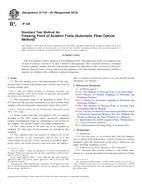We need your consent to use the individual data so that you can see information about your interests, among other things. Click "OK" to give your consent.
ASTM D7154-05(2010)
Standard Test Method for Freezing Point of Aviation Fuels (Automatic Fiber Optical Method)
STANDARD published on 1.5.2010
The information about the standard:
Designation standards: ASTM D7154-05(2010)
Note: WITHDRAWN
Publication date standards: 1.5.2010
SKU: NS-37695
The number of pages: 8
Approximate weight : 24 g (0.05 lbs)
Country: American technical standard
Category: Technical standards ASTM
Annotation of standard text ASTM D7154-05(2010) :
Keywords:
automatic freezing point, automatic fiber optical method, aviation gasoline, aviation turbine fuels, freezing point, Automatic fiber optical method, Aviation turbine fuels, Freezing point--petroleum products/applications, Hydrocarbon crystals, Petroleum products, ICS Number Code 75.160.20 (Liquid fuels)
Additional information
| Significance and Use | ||||||||||||||
|
The freezing point of an aviation fuel is an index of the lowest temperature of its utility for certain applications. Solid hydrocarbon crystals can restrict the flow of fuel in the fuel system of the aircraft. The temperature of the fuel in the aircraft tank normally decreases during flight depending on aircraft speed, altitude, and flight duration. The freezing point of the fuel must always be lower than the minimum operational fuel temperature. Petroleum blending operations require precise measurement of the freezing point. This test method expresses results with a resolution of 0.1°C. This test method eliminates most of the operator time and judgment required by Test Method D2386. When the specification requires the use of Test Method D2386, do not substitute this test method or any other method. |
||||||||||||||
| 1. Scope | ||||||||||||||
|
1.1 This test method covers the determination of the temperature below which solid hydrocarbon crystals may form in aviation turbine fuels. Note 1—This test method describes an alternative procedure and automatic apparatus which closely mimics the apparatus and procedure described in Test Method D2386. 1.2 The measuring range of the apparatus is from -70 to 0°C, however the precision statements were derived only from samples with freezing point temperatures from -60 to -42°C. Note 2—Typical aviation fuel has freezing point temperatures in the -60 to -40°C range. 1.3 Some results from this test method (14% of samples included in the 2003 round robin ) incorrectly identified sample contamination where no contaminants were present in the samples (see research report for further information). 1.4 The values stated in SI units are to be regarded as standard. No other units of measurement are included in this standard. 1.5 This standard does not purport to address all of the safety concerns, if any, associated with its use. It is the responsibility of the user of this standard to establish appropriate safety and health practices and determine the applicability of regulatory limitations prior to use. For specific hazard statements, see Section 7. |
||||||||||||||
| 2. Referenced Documents | ||||||||||||||
|
We recommend:
Technical standards updating
Do you want to make sure you use only the valid technical standards?
We can offer you a solution which will provide you a monthly overview concerning the updating of standards which you use.
Would you like to know more? Look at this page.




 Cookies
Cookies
